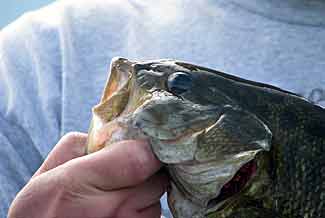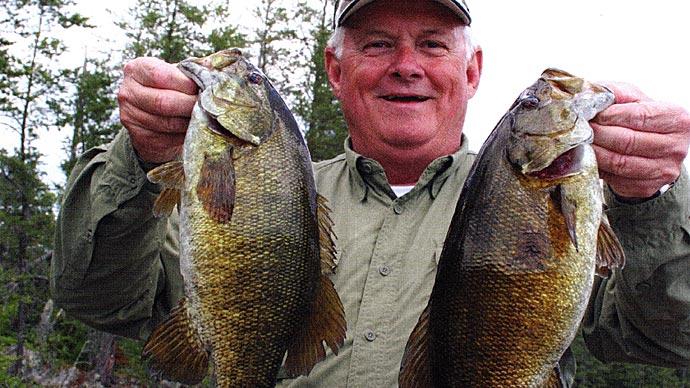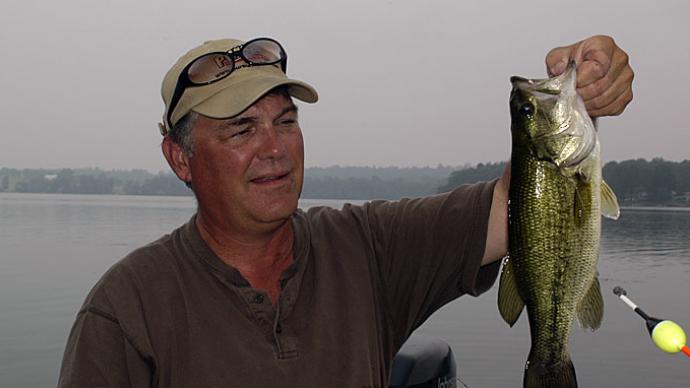
Wednesday brought in one of those mean cold fronts, howling down out of some frozen wasteland at the North Pole. On Thursday, temperatures dipped into the 30s after being in the high 70s just the day before. Fish was as bad as I've ever experienced it.
A large group of bass moved up the creek channel into the cove that I had been fishing just a few days before into the cove that I had been fishing just a few days before the front. I decided the fish must still be there, so I went to the same cove again. Sure enough, they were there but had pulled just a little tighter to the creek channel and a little deeper in the hydrilla that lined the creek bed.
I could "see" the fish with my front-mounted Lowrance graph. We threw everything we had at them, but we couldn't catch a single one. We came up with a big goose egg.
To my good fortune, one of the gentlemen I had in the boat that day was a preacher. At lunch, he said a prayer for better fishing. I sure wish I could remember those words because they worked.
I decided to drop line size at lunch and go to small 2 ½-inch grubs and Road Runners. I broke out the Zebco 33's with 10-pound line and my spinning rod.
We went back to the same spot after lunch. Using light tackle, we landed 21 bass, had three break off, and missed several fish.
The moral of the story is to pray for good fishing, but don't forget to drop down line size and baits when fishing gets tough. Fishing the smaller lures does mean you'll miss some fish. Bass will short-strike the baits, but the way I look at it is that at least you're getting the bites to miss.
One of the keys to using a light line is to pick your place. You can't fish in heavy timber. You have to fish in an area where fish can run. One prime location at Lake Fork is in the back of Penson Bay. There is a big hydrilla bed and a creek channel that comes into its back.
Fishing ultra-light lines around hydrilla beds can be deadly. Make long casts and swim your bait across the top of the grass, letting it just tick the top of the hydrilla as it moves across it. Let the bait fall occasionally down into the grass, popping it out once it has hit bottom. Yes, you will constantly be picking grass off your lure, but you will also be picking bass off it now and then.
Lines such as Power Pro or Spiderwire are good for fishing ultra-light lures. They cut the hydrilla like a knife when you pop the lure because a piece of 20-pound Power Pro is like a piece of sewing thread. It's so thin.
Using a heavy ultra-light line is like cheating, but you will get the strength of a 20-pound line and the flexibility of a 10-pound monofilament. I have seen times after a cold front that bass would only hit a lure on 8- or 10-pound test mono. This can be attributed to the invisibility of a line that small.
Another excellent place to fish ultra-light tackle is around concrete structures. I don't mean for crappie, either. Bass love to hang out around old submerged bridges, rock points, bridge columns, etc. I have always noticed an abundance of shad around concrete structures. This is, of course, what brings the bass to them.
Concrete makes me break out the 2-inch Mister Twister Fightin' Craw. I rig this small crawdad on 10-pound line with a 3/16-ounce split shot and an 18-inch leader with a 1/0 bent shank, ultra-sharp hook. This rig works well when fished like you would a Carolina rig. Used on rocky points or in sparse hydrilla, you might be surprised at the bass you can catch.
I stress ultra-sharp hooks when fishing light line because you can't use an over-the-head, wrist-cracking, lip-jerking, rod-breaking, killer hook set. You must learn to use a sweeping, firm hook set, keeping your line tight and continuing the pressure on the fish. An ultra-sharp hook like an Owner or Gamakatsu will penetrate the bass' mouth. A vicious hook set will break the light line before you can even feel the fish.
Most people think that using small lures will only catch small bass. To a certain extent, this can be true. You will get more bites, therefore catch more fish, of which many will be smaller, on smaller baits. But there will be large fish caught on small baits as well. My largest bass on ultralight tackle was 9 ½ pounds, but I have had several in the 4- to 8- pound range.
I have fished ultra-light tackle from Lake Fork and Bob Sandlin, where I usually fish, to Fort Phantom in west Texas, Table Rock in Missouri, and every lake I've fished. Light tackle works everywhere. It can work when nothing else will, which I like best about the technique.
Light tackle is so versatile it can be used on any lake at almost any time of the year. For a serious tournament angler, this versatility can make the difference between getting a check and going home with the blues.
In my experience with ultra-light, there are two components that can be put to good use in bass fishing. I like a Zebco spincast reel when the bass are biting super light. You can cup your hand over the reel and run the line across your index finger for maximum sensitivity. I put this $25 reel on a 6-foot Berkley Series One rod to give me a very light and powerful combination.
The reel is great for accuracy and skipping a gitzit or grub under boat docks. A spinning reel can also be suitable for this, but I prefer to use the spinning reel for Carolina/split shot type fishing, where you can use a sweeping hook set. Sensitivity isn't as big a factor with this type of fishing, though some folks may not agree. I'm not big on feeling a fish through the rod blank. I still like to feel the line across my finger. In my opinion, there's nothing more sensitive than that.
Some excellent ultralight lures are Road Runners, gitzits, 2-inch craws, grubs, and 4-inch worms. All of these baits will catch fish if you give them a try.
And sometimes, a little prayer doesn't hurt, either.




